Space Weathering Trends at the Mare Moscoviense Swirl
- 1TU Dortmund University, Electrical Engineering and Information Technology, Image Analysis Group, Dortmund, Germany (marcel.hess@tu-dortmund.de)
- 2Sternberg Astronomical Institute, Moscow State University 119234 Moscow, Russia
- 3Planetary Sciences Division, Physical Research Laboratory Ahmedabad 380009, India
Introduction:
Swirls are bright albedo features only found on the lunar surface. Almost every swirl is associated with a magnetic anomaly [e.g., 1, 2]. Therefore, a common explanation for the higher albedo of the swirls compared to their surroundings is that the magnetic shield deflects the solar wind and consequently protects the surface from space weathering [e.g., 3]. This would explain why these features often appear to be less mature compared to their surroundings. Another process that might play a role in the formation of the swirls are interactions with cometary material [e.g., 4]. Gas moving at high speed, thus acting like a landing rocket jet [5], removes the uppermost layer of mature material [6], so that subsequent magnetic shielding prevents the surface from maturing. This may also results in soil compaction [5]. A combination of soil compaction and space weathering effects is able to explain observed spectral trends at lunar swirls [7].
To better characterize the spectral trends of the swirl in Mare Moscoviense [2, 8], we extract the spectral charactersitics of the swirl based on spectral pairs and space weathering modeling to artificially space weather the immature fresh spectra to best fit the dark mature spectra. We compare the results to those obtained in [9] for typical small fresh mare craters.
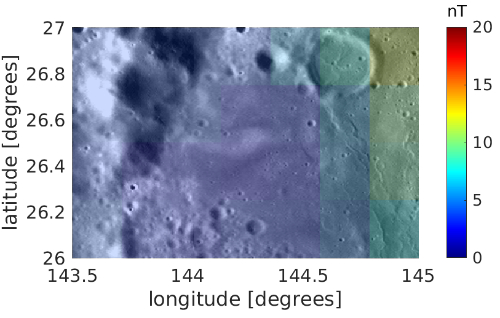
Figure 1: Swirl in Mare Moscoviense: magnetic flux density [10] overlaid on Lunar Reconnaissance Orbiter (LRO) Wide Angle Camera (WAC) mosaic [11]. The maximum magnetic flux density of this region is 11.4nT.
Data and Methods:
This study utilizes normalized spectra of the M3 instrument [12] and our recent space weathering simulation framework [9]. Additionally, we analyze the magnetic flux density maps of [10]. The M3 data are processed with the method described in [13,14,15] by applying topographic, thermal [16] and roughness correction [15, 17]. State-of-the-art space-weathering models such as [9, 18, 19, 20, 21] build upon the current distinction into nanophase iron particles (npFe) that are responsible for reddening and darkening and larger microphase iron particles (mpFe) that only cause darkening [18, 22]. We devised an ab-initio Mie-modeling approach [9] that is used to determine the amount of npFe and mpFe associated with the Mare Moscoviense swirl and the reference region around the craters Bessel F and G. We sample pairs that consist of a spectrum of typical immature soil (either on-swirl or fresh mare crater) and one from a nearby mature mare location, so that it can be safely assumed that the soil composition is identical. Finally, a non-linear optimization scheme used to estimate the amount of npFe and mpFe that is necessary for the modeled immature spectra to best match their corresponding observed mature spectra [9].
Results:
The swirl structure near Mare Moscoviense on the lunar farside is unique in the sense that the magnetic flux density given by [10] at the surface is mostly below 10nT (see Figure 1), while other swirls are associated with magnetic anomalies of several hundred nT [2, 10]. In Figure 2 the best-fit abundance of npFe and mpFe for the swirl are shown at their corresponding on-swirl locations. In Figure 3 the best-fit abundances are shown for the fresh mare craters. The resulting deviations between the measured and modeled mature spectra are very low (for a detailed discussion see [9]). Both regions show a strong correlation between mpFe and npFe weight percentages (Mare Moscoviense: r = 0.978; Bessel F/G: r = 0.962). This trend is illustrated in Figure 4. Consequently, a higher abundance of npFe corresponds to more mpFe in both regions. This trend appears to be largely linear for both regions, but with slightly different slopes.
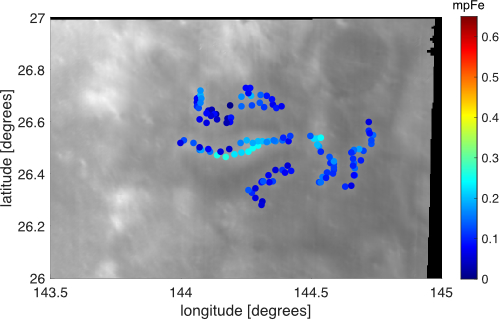
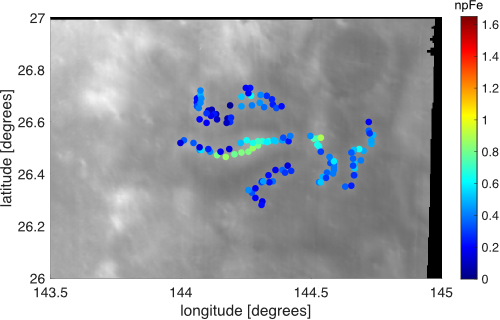
Figure 2: Best-fit mpFe and npFe weight percentages at the Mare Moscoviense swirl overlaid on the 1.579 μm reflectance derived from the M3 data set [12, 23].
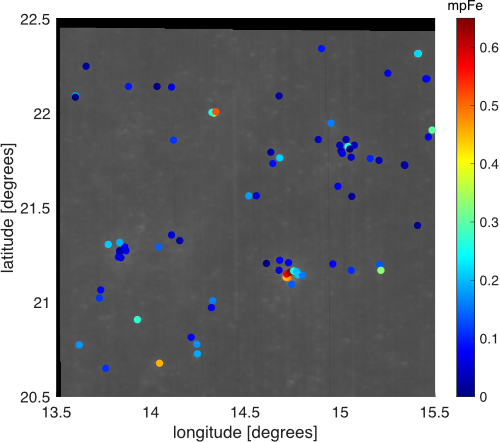
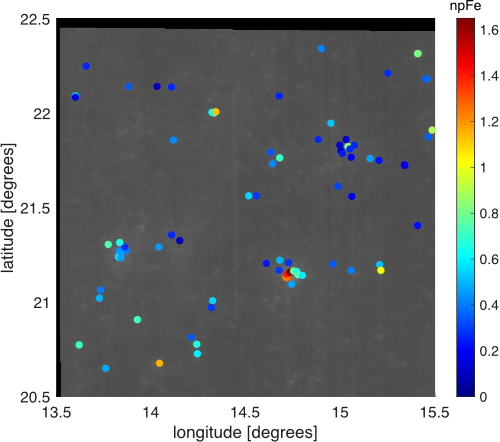
Figure 3: Best-fit mpFe and npFe weight percentages in the Bessel F and G region overlaid on the 1.579 μm reflectance derived from the M3 data set [12, 23].
Figure 4: Weight percentage differences of mpFe and npFe particles between fresh and mature spectra (crater data from [9]).
Conclusion:
The spectral differences at the Mare Moscoviense swirl correspond to a difference in maturity even without a relevant magnetic field that would shield the surface from space weathering. This means that magnetic shielding alone cannot explain the origin of this swirl. A possible explanation for the immaturity is the resurfacing of immature regolith by cometary gas as suggested by [5] and described for a landing rocket jet by [6]. The linear correlation between the npFe and mpFe values is another clue that both types of particles are created by similar processes.
[1] L.L. Hood and G. Schubert, 1980. Science, 208(4439):49–51.
[2] B.W. Denevi et al., 2016. Icarus, 273:53–67.
[3] R.A. Bamford et al., 2016. Astrophys. J., 830(2).
[4] P.H. Schultz and L. J. Srnka, 1980. Nature, 284:22–26.
[5] V.V. Shevchenko, 1993. Astronomy Reports, 37: 314–319.
[6] Y. Wu and B. Hapke, 2018. EPSL, 484:145–153.
[7] M. Hess et al., 2020. Astronomy and Astrophysics, in press.
[8] D.T. Blewett et al., 2011. JGR Planets, 116(E2).
[9] K.S. Wohlfarth et al., 2019. The Astronomical Journal, 158(2):80.
[10] H. Tsunakawa et al., 2015. JGR Planets, 120(6):1160–1185.
[11] R.V. Wagner, et al., 2015. LPSC XXXXVI, abstract #1473.
[12] C.M. Pieters et al., 2009. Curr. Sci., 96: 500–505.
[13] C. Wöhler et al., 2017. Science Advances, 3: e1701286.
[14] C. Wöhler et al., 2017. Icarus, 285:118 – 136.
[15] A. Grumpe et al., 2019. Icarus, 321:486 – 507.
[16] Y. Shkuratov et al., 2011. PSS, 59(13):1326 – 1371.
[17] B.J.R. Davidsson et al., 2015. Icarus, 252:1–21.
[18] P.G. Lucey and M. A. Riner, 2011. Icarus, 212(2): 451 – 462.
[19] D. Trang and P. G. Lucey, 2019. Icarus, 321:307– 323.
[20] S. Gou et al., 2020. EPSL, 535:116117.
[21] A. Penttilä et al., 2020. Icarus, 345:113727.
[22] C.M. Pieters and S.K. Noble, 2016. JGR Planets, 121(10):1865–1884.
[23] NASA and JPL. Planetary data system. https://pds-imaging.jpl.nasa.gov/volumes/m3.html, 2019.
How to cite: Hess, M., Wohlfarth, K., Wöhler, C., Berezhnoy, A. A., Bhatt, M., and Bhardwaj, A.: Space Weathering Trends at the Mare Moscoviense Swirl, Europlanet Science Congress 2020, online, 21 Sep–9 Oct 2020, EPSC2020-716, https://doi.org/10.5194/epsc2020-716, 2020.

